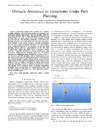Identificador persistente para citar o vincular este elemento:
https://accedacris.ulpgc.es/jspui/handle/10553/48305
| Título: | Obstacle avoidance in underwater glider path planning | Autores/as: | Isern-González, Josep Hernández-Sosa, Daniel Fernández-Perdomo, Enrique Cabrera-Gámez, Jorge Domínguez-Brito, Antonio C. Prieto-Marañón, Víctor |
Clasificación UNESCO: | 120304 Inteligencia artificial 120326 Simulación 331913 Vehículos submarinos |
Palabras clave: | Obstacle avoidance Path planning Underwater gliders |
Fecha de publicación: | 2012 | Proyectos: | Tecnicas de Visión Para la Interacción en Entornos de Interior Con Elaboración Mapas Cognitivos en Sistemas Perceptuales Heterogéneos. | Publicación seriada: | Journal of Physical Agents | Resumen: | Underwater gliders have revealed as a valuable scientific platform, with a growing number of successful environmental sampling applications. They are specially suited for long range missions due to their unmatched autonomy level, although their low surge speed makes them strongly affected by ocean currents. Path planning constitutes a real concern for this type of vehicle, as it may reduce the time taken to reach a given waypoint or save power. In such a dynamic environment it is not easy to find an optimal solution or any such requires large computational resources. In this paper, we present a path planning scheme with low computational cost for this kind of underwater vehicle that allows static or dynamic obstacle avoidance, frequently demanded in coastal environments, with land areas, strong currents, shipping routes, etc. The method combines an initialization phase, inspired by a variant of the A* search process and ND algorithm, with an optimization process that embraces the physical vehicle motion pattern. Consequently, our method simulates a glider affected by the ocean currents, while it looks for the path that optimized a given objective. The method is easy to configure and adapt to various optimization problems, including missions in different operational scenarios. This planner shows promising results in realistic simulations, including ocean currents that vary considerably in time, and provides a superior performance over other approaches that are compared in this paper. | URI: | https://accedacris.ulpgc.es/handle/10553/48305 | ISSN: | 1888-0258 | DOI: | 10.14198/JoPha.2012.6.1.03 | Fuente: | Journal of Physical Agents [ISSN 1888-0258], v. 6(1), p. 11-20 |
| Colección: | Artículos |
Los elementos en ULPGC accedaCRIS están protegidos por derechos de autor con todos los derechos reservados, a menos que se indique lo contrario.
